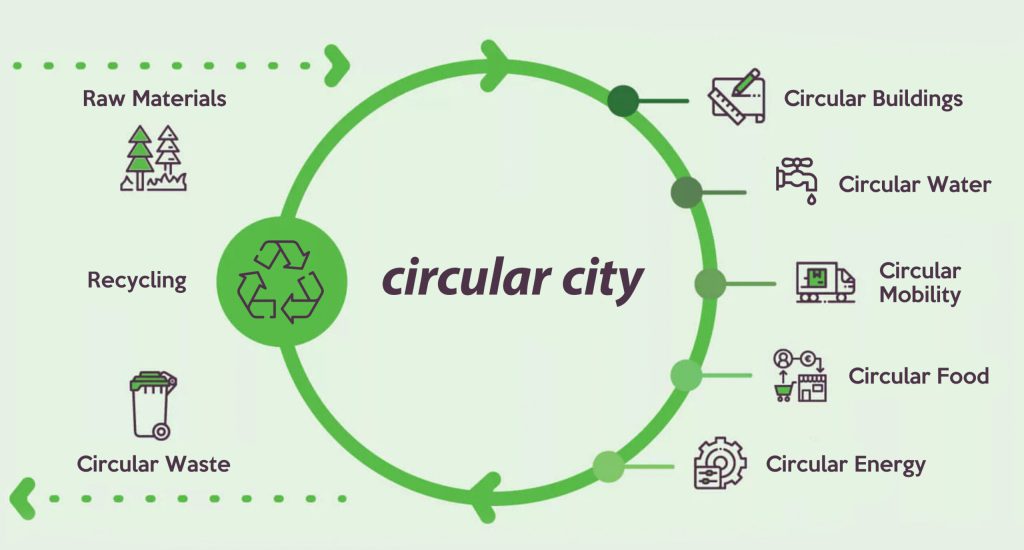
Circular cities: Explore How Urban Environments are Adopting Circular Economy Principles for a Sustainable Future
The concept of circular economy is based on the idea of designing out waste and pollution, keeping products and materials in use, and regenerating natural systems. In a circular economy, resources are used more efficiently and effectively, creating value for society, the environment and the economy.
But how can this concept be applied to urban environments? More than half of the world’s population lives and most of the environmental and social challenges are concentrated in urban spaces. How can cities become more circular and resilient, while improving the quality of life of their inhabitants?
In this blog post, we will explore some of the ways that urban environments are adopting circular economy principles for a sustainable future. We will look at some examples of circular cities around the world, and discuss the benefits and challenges of implementing circular solutions in urban contexts.
What are Circular Cities?
Circular cities are urban environments that apply the principles of circular economy to their design, planning and management. They aim to reduce their environmental impact, optimize their resource use, and enhance their social and economic well-being.
These cities can be seen as systems of systems, where different sectors and actors interact and collaborate to create synergies and positive outcomes. Circular cities can involve various aspects, such as:
- Circular buildings: Buildings that are designed, constructed and operated in a way that minimizes waste, energy and water consumption, and maximizes the reuse and recycling of materials.
- Circular mobility: Mobility systems that are based on low-carbon and shared modes of transport, such as public transport, cycling and walking, and that promote accessibility and connectivity.
- Circular energy: Energy systems that are based on renewable sources, such as solar, wind and biomass, and that enable decentralized production, distribution and storage of energy.
- Circular water: Water systems that are based on efficient use, reuse and recovery of water resources, such as rainwater harvesting, wastewater treatment and greywater recycling.
- Circular food: Food systems that are based on local and organic production, consumption and distribution of food, and that reduce food waste and losses along the value chain.
- Circular waste: Waste systems that are based on prevention, reduction, reuse and recycling of waste materials, such as composting, biogas production and upcycling.
Examples of Circular Cities
There are many examples of circular cities around the world, each with its own characteristics, challenges and opportunities. Here are some of them:
- Amsterdam: The capital of the Netherlands is one of the pioneers of circular economy in Europe. In 2015, it launched its Circular Amsterdam programme, which aims to transform the city into a circular hotspot by 2050. The programme focuses on four key areas: biomass and food, construction, consumer goods and plastics. Some of the initiatives include: a circular innovation lab for startups; a circular tendering process for public procurement; a circular pavilion for events; a circular fashion project; a plastic-free rivers campaign; and a community composting network.
- Copenhagen: The capital of Denmark is another leading example of circular economy in Europe. In 2019, it published its Circular Copenhagen strategy, which aims to make the city carbon-neutral by 2025 and fully circular by 2035. The strategy focuses on three main themes: design for disassembly; sharing platforms; and green procurement. Some of the initiatives include: a green roof policy; a bike-sharing scheme; a textile recycling facility; a circular construction hub; a green business network; and a circular procurement guide.
- Singapore: The city-state of Singapore is one of the most densely populated and resource-scarce countries in the world. It has been pursuing a circular economy approach for decades, especially in the areas of water and waste management. Some of its achievements include: achieving water self-sufficiency through desalination, water reuse and rainwater collection; achieving one of the highest recycling rates in the world; developing an integrated waste management system that converts waste into energy; creating a zero-waste masterplan that aims to reduce waste sent to landfill by 30% by 2030; and promoting circular innovation through research grants and awards.
Benefits and Challenges of Circular Cities
Circular cities offer many benefits for urban environments, such as:
- Reducing greenhouse gas emissions and air pollution
- Saving costs and creating new revenue streams
- Enhancing resource security and resilience
- Improving health and well-being
- Creating new jobs and business opportunities
- Fostering social inclusion and participation
However, circular cities also face many challenges, such as:
- Changing consumer behavior and preferences
- Aligning policies and regulations across different levels
- Overcoming technical barriers and knowledge gaps
- Mobilizing financial resources and incentives
- Engaging stakeholders and building partnerships
Conclusion
Circular economy is a promising concept for urban environments. It can help address some of the most pressing environmental and social issues of our time. Circular cities are emerging as innovative and inspiring examples of how urban systems can be transformed to become more sustainable, efficient and inclusive. However, circular cities also require a systemic and collaborative approach, involving multiple actors and sectors, and overcoming various barriers and challenges. By learning from each other and sharing best practices, circular cities can pave the way for a more circular and sustainable future.
If you liked this article, you might also like Sustainable Transportation: Green Mobility Solutions

